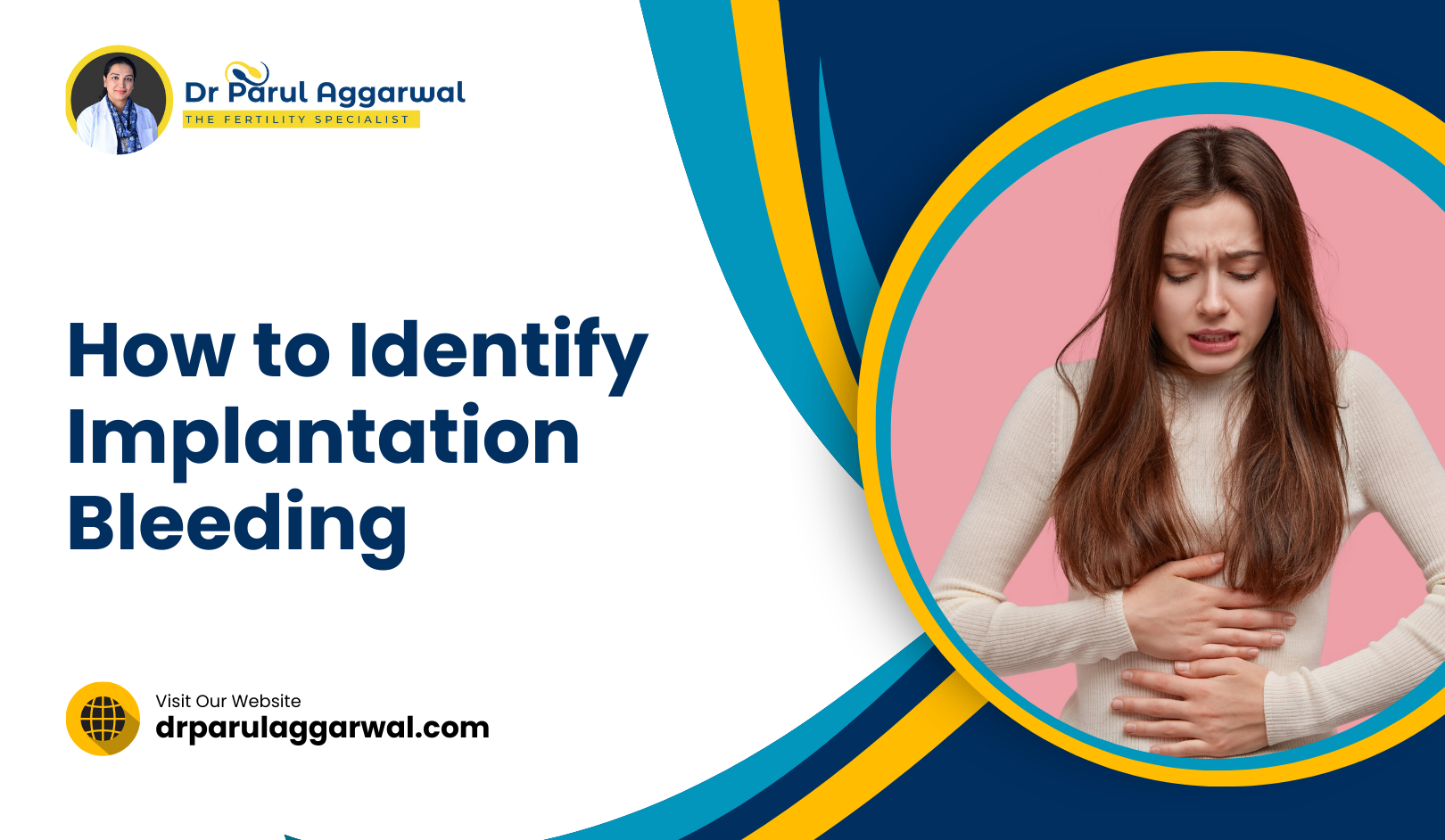One of the earliest signs of pregnancy that can be confusing for many women is implantation bleeding. This subtle yet significant event occurs when a fertilized egg attaches itself to the lining of the uterus, marking the first step in pregnancy. However, because implantation bleeding can resemble light spotting or a menstrual period, it often leaves women wondering whether it is an early sign of pregnancy or just a regular period.
In this article, we’ll help you understand how to identify implantation bleeding, the causes behind it, common symptoms, and what to expect if you experience it. As a fertility specialist, Dr. Parul Aggarwal offers insights to guide you through this exciting but sometimes confusing stage of early pregnancy.
What is Implantation Bleeding?
Implantation bleeding happens when the fertilized egg, or embryo, travels through the fallopian tube and implants itself into the uterine lining. This occurs around 6 to 12 days after ovulation and fertilization. As the embryo burrows into the uterus, it may cause slight damage to the blood vessels in the uterine lining, resulting in light bleeding or spotting.
Implantation bleeding is considered one of the earliest signs of pregnancy and often occurs around the time when you might expect your next menstrual period. This can lead to confusion for women who may mistake it for a lighter-than-usual period.
Causes of Implantation Bleeding
Implantation bleeding occurs as a natural part of the early pregnancy process. Here’s what happens:
- Fertilization: After ovulation, sperm meets the egg in the fallopian tube, leading to fertilization.
- Embryo Development: The fertilized egg begins to divide and grow, forming a blastocyst.
- Travel to the Uterus: The blastocyst travels through the fallopian tube to reach the uterus.
- Implantation: The blastocyst attaches to the uterine wall, causing a slight disruption to the blood vessels, which may result in light bleeding.
It’s important to note that implantation bleeding is harmless and a completely normal part of early pregnancy. However, not all women experience implantation bleeding, and its absence doesn’t mean you’re not pregnant.
Symptoms of Implantation Bleeding
To help you identify whether the bleeding you’re experiencing is due to implantation, here are some common symptoms:
1. Timing of the Bleeding
Implantation bleeding usually occurs around 6 to 12 days after ovulation, or about a week before your expected period. If you’re experiencing light spotting at this time and you’ve had unprotected intercourse, there’s a chance it could be implantation bleeding.
2. Light Spotting
Unlike a menstrual period, which typically starts light and becomes heavier, implantation bleeding is usually very light. It often appears as a few drops of blood or light spotting. It’s typically pink, light red, or brown in color, rather than the bright red blood seen during a period.
3. Short Duration
Implantation bleeding typically lasts anywhere from a few hours to 2 days. In contrast, a menstrual period can last 3 to 7 days. If the bleeding stops quickly, it’s more likely to be implantation bleeding than a period.
4. No Clotting
While some women experience clotting during their period, implantation bleeding does not usually involve blood clots. It’s more of a light, steady spotting.
5. Mild Cramping
Some women experience mild cramping during implantation bleeding, though it’s typically lighter than menstrual cramps. If you feel a slight discomfort around the time of spotting, it could be due to the embryo attaching to the uterine lining.
6. No Accompanying PMS Symptoms
Menstrual periods are often accompanied by premenstrual symptoms such as bloating, breast tenderness, fatigue, and mood swings. Implantation bleeding, on the other hand, is usually not associated with these symptoms, or they are much milder.
How to Differentiate Between Implantation Bleeding and a Period
Because implantation bleeding can occur around the time of your period, it’s essential to know the differences between the two:
| Implantation Bleeding | Menstrual Period |
|---|---|
| Light spotting or pink/brown discharge | Typically heavier, with bright red blood |
| Lasts a few hours to 2 days | Lasts 3 to 7 days |
| No clots present | Clots may be present |
| Occurs 6 to 12 days after ovulation | Occurs 14 days after ovulation |
| Accompanied by mild cramping (if any) | May involve moderate to severe cramps |
| No typical PMS symptoms | May involve bloating, mood swings, fatigue, etc. |
If you’re unsure whether the bleeding is implantation bleeding or your period, consider other early signs of pregnancy, such as nausea, fatigue, and breast tenderness. A home pregnancy test can provide clarity, but it’s best to wait at least a few days after the bleeding stops to take it, as implantation bleeding occurs before hCG levels (pregnancy hormone) are detectable.
What Should You Do If You Experience Implantation Bleeding?
If you suspect you’re experiencing implantation bleeding, it’s important to:
- Track the Timing: Note when the spotting occurs and how long it lasts. Compare this to your usual menstrual cycle.
- Monitor Symptoms: Pay attention to any early pregnancy symptoms, such as nausea, fatigue, or tender breasts.
- Take a Pregnancy Test: Wait a few days after the bleeding stops before taking a home pregnancy test. It’s best to take the test at least a day or two after your missed period for the most accurate result.
If you receive a positive pregnancy test result or have any concerns about your bleeding, it’s a good idea to consult your doctor for further guidance.
When to Seek Medical Advice
Although implantation bleeding is generally harmless, it’s essential to know when to seek medical advice. If the bleeding becomes heavy, lasts longer than a few days, or is accompanied by severe cramping, you should consult your healthcare provider. Heavy bleeding could be a sign of other conditions, such as miscarriage or an ectopic pregnancy, which require medical attention.
Conclusion: Understanding Implantation Bleeding with Dr. Parul Aggarwal
Implantation bleeding is an exciting early sign of pregnancy that occurs when a fertilized egg attaches to the uterine lining. While it’s easy to confuse this light spotting with a menstrual period, paying attention to the timing, color, and amount of bleeding can help you identify it as implantation bleeding. Dr. Parul Aggarwal and her team are dedicated to helping women understand every aspect of their fertility journey, from early pregnancy signs to fertility treatments.
If you have questions about implantation bleeding, fertility, or pregnancy, don’t hesitate to contact Dr Parul for expert advice and compassionate care. Let us support you every step of the way on your journey to parenthood.

